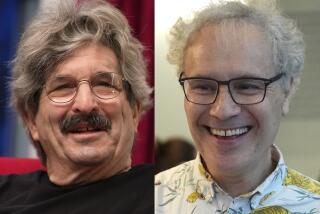2 U.S. cardiologists share Nobel Prize for chemistry
Two American physicians who solved a key part of the mystery of how cells in the body are able to sense and respond to chemical messages -- a discovery that paved the way for an estimated 40% of the prescription drugs available today -- have won the Nobel Prize in chemistry.
Dr. Robert J. Lefkowitz of Duke University Medical Center and Dr. Brian K. Kobilka of Stanford University School of Medicine were honored Wednesday by the Royal Swedish Academy of Sciences for their studies of signaling molecules known as G-protein-coupled receptors, or GPCRs.
Scientists had long known that hormones directed the action of cells. But for most of the 20th century, it remained unclear how.
“These guys showed what the ‘on’ switch was,” said Dr. David Agus, a professor of medicine and engineering at USC.
Their breakthrough gave drug makers a new way to target disease, forming “a fundamental building block of what we do today,” Agus said.
Among the popular drugs that trace their existence to the work of Lefkowitz and Kobilka are the beta blockers that control blood pressure, the allergy medicine Clarinex and the acid reflux drug known as Zantac.
GPCRs are embedded in the membrane of cells. When a target molecule -- a hormone such as adrenaline or a neurotransmitter like dopamine -- attaches to the part of the receptor on the cell’s surface, the shape of the receptor on the inside of the cell changes slightly. This change begins the cell-signaling process.
It’s like “a lock and key,” Lefkowitz said at a news conference Wednesday.
In the 1970s, the existence of such target-specific receptors was a highly controversial idea. But Lefkowitz, a cardiologist by training who was studying hormones like adrenaline at the time -- “It seemed relevant to cardiovascular disease,” he said -- developed a way to use radioactive tracers to determine just what the hormones bound to in order to cause an effect in the body, such as the “fight or flight” response.
By the mid-1980s, Kobilka, also a cardiologist who worked with Lefkowitz at Duke, had demonstrated that there was a whole family of GPCRs that are activated by different molecules.
Determining the physical structure of the receptors was a painstaking process, said David Eisenberg, a protein researcher at UCLA.
The GPCRs were very small -- just a thousandth of a millimeter -- and rather floppy, which made them difficult to manipulate and examine using X-ray crystallography, a technique that involves shooting X-rays at tiny crystals to reveal the arrangement of their atoms. Kobilka persisted, and his ultimate success in describing the receptors’ structures opened up enormous possibilities for targeted drug development.
Clinicians target the opioid receptor, for instance, to control pain. But activating that receptor can also lead to addiction. In principle, Eisenberg said, knowing the precise structure and interaction of the receptor and its target molecule could make it possible to design a drug that could reduce pain without getting patients hooked.
“By coincidence, I taught one of his papers in my class on Tuesday, and I did tell my students, ‘This is the type of work that merits a Nobel Prize,’” he said.
Today, scientists believe that there are hundreds of these receptors that react to odorants from our smells, light-sensitive molecules in our eyes, and a host of others.
Though the receptors have been particularly well studied in the brain, they also play important roles in the immune system and in regulating other key body functions.
“There’s no field of medicine that doesn’t have receptors that are impacted,” Lefkowitz, 69, said.
Last year, Kobilka, now 57, managed to capture an image of a GPCR at the precise moment that its target molecule arrived at the cell surface and triggered a signaling cascade -- a feat the Swedish Academy described as “a molecular masterpiece.”
--
eryn.brown@latimes.com
Special correspondent Bardin reported from New York and Times staff writer Brown from Los Angeles.







